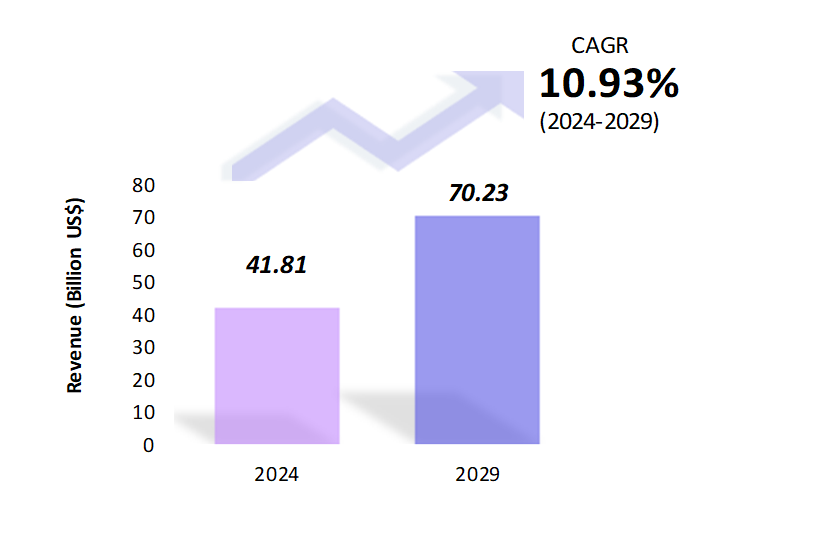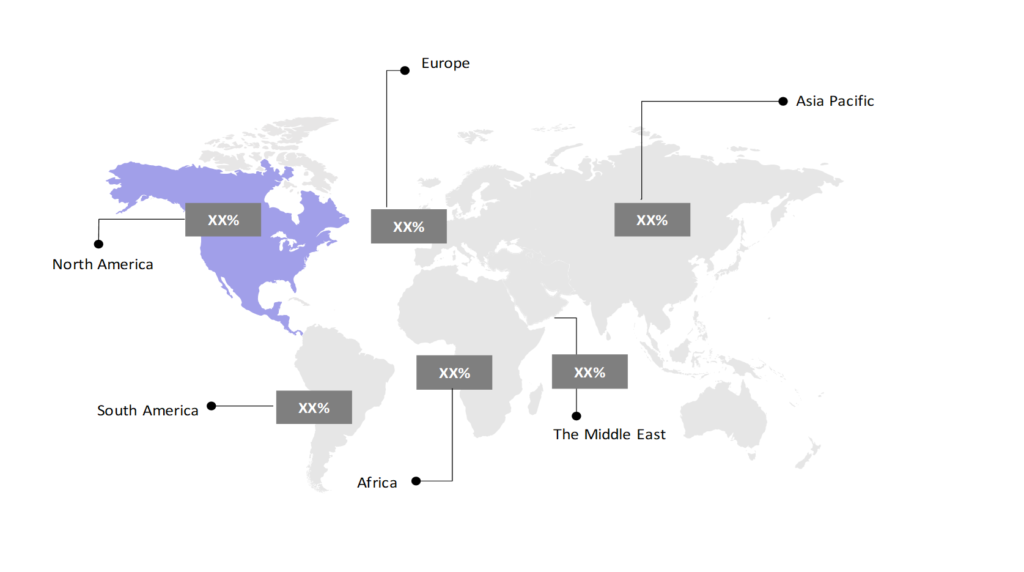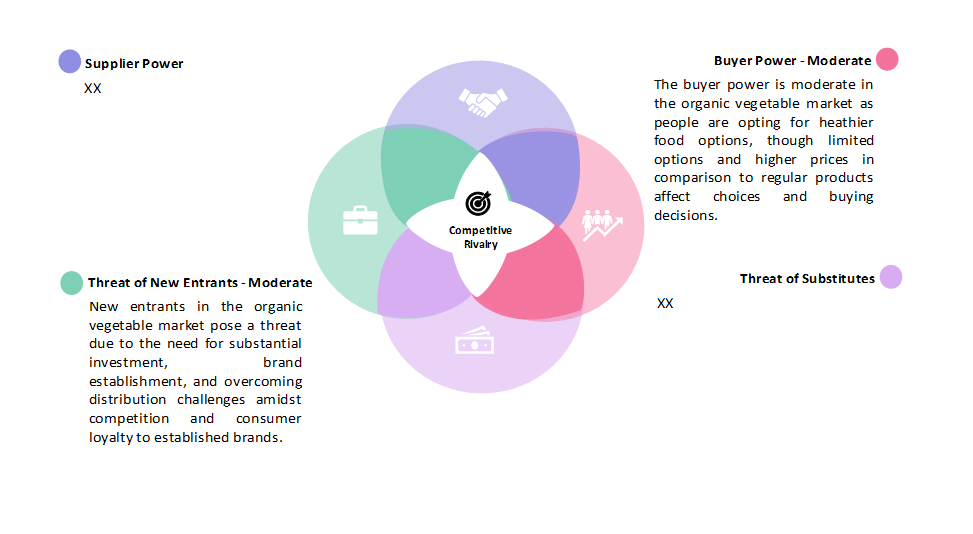Organic Vegetables Market Insights: Size, Share, Growth Analysis & Forecast (2024-2029)
The report covers a comprehensive analysis segmented by Type (Organic Vegetables, Organic Fruits), By Form (Frozen, Fresh), By Distribution Channel (Hypermarkets, Supermarkets, Online Sale Channel, Convenience Store, Others), By End User (Commercial, Residential), By Geography (North America, South America, Asia Pacific, Europe, the Middle East, Africa).
Organic Vegetables Market Snapshot

Organic Vegetables Market Overview
The market for organic vegetables is projected to grow from $41.81 billion in 2024 to $70.23 billion in 2029. The market for organic veggies is expected to grow at a compound annual growth rate (CAGR) of 10.93% between 2024 and 2029.
The organic vegetable market has been expanding globally in recent years. Across every region in North America, Europe, and Asia-Pacific, organic vegetables have gained popularity due to their perceived health benefits, including higher nutritional value and the absence of synthetic chemicals. The increase in consumer knowledge regarding the benefits of organic farming has led to its growth and development. The system of organic farming is growing, the animals under organic farming are fed with an organic supply devoid of synthetic growth hormones, genetically modified organisms, or antibiotics.
As compared to conventional farming, organic products are rich in storehouses of minerals, which is the key driver for market growth. The organic products are devoid of any hydrogenated fat in the form of polyunsaturated fatty acids and are usually produced using thermophilic composting, which minimizes the risk of any heart-related ailments. Due to the rise in disposable incomes, consumers around the globe are presently more focused on healthier diets, with more vegetable and fruit inclusion. Moreover, the interest in wellness and immunity has spiked in recent years, leading to a higher demand for organic fruits and vegetables in the market. This factor is likely to have a massive impact on market growth. Due to the increasing consumer demand, there is an astounding rise in the area under organic cultivation.
Organic Vegetables Market Coverage
| Historical & Forecast Period | 2018-2029 |
| Base Year | 2023 |
| Forecast Period | 2024-2029 |
| Units | Billion US$ |
| Segments | Type, Form, Distribution channel, End User |
| Geographies | North America, South America, Asia Pacific, Europe, The Middle East, Africa |
| Key Vendors |
Danone North America Public Benefit Corp., Z Natural Foods LLC, Iceland Foods Ltd., Green Organic Vegetables Inc., DMH Ingredients, Inc. |
Key Geographies of Organic Vegetables Market, 2023

Porter’s 5 Forces Analysis of Organic Vegetables Market

Organic Vegetables Market Trends
The organic vegetables market witness visible growth and notable trends due to an increase in consumer awareness about healthy and organically grown fruits and vegetables. The food safety concerns and farming practices that contribute to a better and more sustainable environment led to the popularization of organic farming techniques. Demand for organic produce remains strong, buoyed by consumers’ perception of it being healthier and safer due to the absence of synthetic pesticides and fertilizers. Supermarkets and grocery stores are expanding their organic sections to cater to this growing demand, while online sales of organic vegetables have surged, particularly accelerated by the COVID-19 pandemic.
Concurrently, there is a discernible shift towards supporting local and small-scale producers, with consumers seeking transparency in labeling and certifications. Innovation in organic farming techniques, such as hydroponics and vertical farming, is broadening the range of available products, while sustainable farming practices gain traction, aligning with consumers’ increasing environmental consciousness.
Artificial Intelligence (AI) has also just entered this industry. It helps with precision agriculture, supply chain optimization, quality control, market analysis, and customer engagement. It enhances efficiency, sustainability, and profitability, facilitating growth and adoption of organic vegetables, from cultivation to consumption. For example- Recently, Ecochoice Naturals, an agricultural startup based in Bengaluru, has introduced a mobile application in collaboration with the Centre for Sustainable Development aimed at facilitating connections between organic farmers and institutional buyers. Additionally, government policies are being renovated and are in favor of cultivating more organically grown fruits and vegetables leading to the growth in the market.
Organic Vegetables Market Driving Factors
The organic vegetable market is jammed with various key drivers that contribute to its growth and sustainability. The constancy of chronic diseases, such as cardiac disorders and cancer, has increased at an alarming rate due to changes in food habits and sedentary lifestyles. So, consumers are taking a drive towards consuming fruits and vegetables cultivated organically. People are consuming organic vegetable juices and syrups, aloe vera juices which are significantly driving market growth. The high nutritional benefits of organically grown fruits and vegetables also increase their demand among health-conscious customers.
Technological advancements in organic agriculture, such as organic pest control methods, and precision farming techniques, enhance productivity and efficiency in organic vegetable production, contributing to market expansion. In addition, government initiatives, including subsidies, certifications, and promotional campaigns, further incentivize farmers to transition to organic farming methods.
Organic Vegetables Market Challenges
Organic vegetable cultivation encounters numerous hurdles that impede their growth and maturation. Among these challenges, the notable barrier lies in the cost and competitive pricing of organic produce, which frequently carries a higher price due to the investments required for organic farming methods and certification. This price differential can pose a challenge for some consumers, particularly those on tighter budgets. The organic supply chain can be considered more complex and less developed as compared to conventional agriculture, leading to challenges in ensuring consistent supply and distribution of organic vegetables. Issues such as transportation, storage, and handling can affect the availability and quality of organic produce, especially in regions with limited organic farming infrastructure.
Obtaining and maintaining organic certification can be a lengthy and costly process for farmers, involving adherence to strict standards and regulations. Organic farms are at risk of pesticide drift and contamination from nearby conventional farms that use synthetic pesticides and fertilizers. This poses a challenge for organic farmers in maintaining the integrity of their crops and complying with organic certification requirements.
Organic Vegetables Market – Key Industry News
- In December 2023, In the Mithi-Virdi region of Bhavnagar, approximately 250 organic farmers came together to host a festival celebrating organic farming called the “Amrit Ahar Utsav 2023” at Jawahar Maidan in Bhavnagar city. This event featured 40 stalls where farmers showcased and sold a variety of organic grains, vegetables, and fruits, along with organically prepared food items.
- In Aug 2020, Amy’s Kitchen, renowned for its organic frozen food items, inaugurated a pizza manufacturing plant in California.
- In March 2024, The Agricultural Marketing Department of West Bengal introduced a unique ‘organic market’ called ‘Sufal Bangla Green’ in New Town. This market will serve as a platform for the sale of seasonal vegetables, fruits, and various other essential ingredients cultivated through organic farming practices.
Organic Vegetables Market Competitive Landscape
In the competitive landscape of the organic vegetables market, companies struggle for market share through product innovation, pricing strategies, and distribution networks. Factors such as quality standards, certification, and sustainable practices play crucial roles. Consumer preferences for healthy and sustainable food options continue to drive demand, prompting companies to invest in organic farming methods and supply chain efficiencies. Rising awareness about environmental concerns and health benefits further intensifies competition. Additionally, partnerships with farmers, retailers, and food service providers enhance market penetration. Overall, the landscape is characterized by dynamic strategies aimed at meeting evolving consumer demands and industry regulations.
The participants in the global organic vegetable industry are always developing their strategies to preserve a competitive advantage. Companies primarily use acquisitions, R&D, partnerships, and technological launches. Several important entities in the organic vegetables market includes White Danone North America Public Benefit Corp., Z Natural Foods LLC, Iceland Foods Ltd., Green Organic Vegetables Inc., DMH Ingredients, Inc., and others.
Organic Vegetables Market Company Share Analysis, 2023 (%)

Organic Vegetables Market – Key Companies

Reason to Buy from us

Table of Contents
| 1. Introduction |
|---|
| 1.1. Research Methodology |
| 1.2. Scope of the Study |
| 2. Market Overview / Executive Summary |
| 2.1. Global Organic Vegetables Market (2018 – 2022) |
| 2.2. Global Organic Vegetables Market (2023 – 2029) |
| 3. Market Segmentation |
| 3.1. Global Organic Vegetables Market by Type |
| 3.1.1. Organic vegetables |
| 3.1.2. Organic fruits |
| 3.2. Global Organic Vegetables Market by Form |
| 3.2.1. Frozen |
| 3.2.2. Fresh |
| 3.3. Global Organic Vegetables Market by Distribution Channel |
| 3.3.1. Hypermarket |
| 3.3.2. Supermarkets |
| 3.3.3. Online sale channel |
| 3.3.4. Convenience Store |
| 3.3.5. Others |
| 3.4. Global Organic Vegetables Market by End User |
| 3.4.1. Commercial |
| 3.4.2. Residential |
| 4. Regional Segmentation |
| 4.1. North America |
| 4.1.1. The U.S. |
| 4.1.2. Canada |
| 4.1.3. Mexico |
| 4.2. South America |
| 4.2.1. Brazil |
| 4.2.2. Argentina |
| 4.2.3. Colombia |
| 4.2.4. Chile |
| 4.2.5. Rest of South America |
| 4.3. Asia Pacific |
| 4.3.1. China |
| 4.3.2. India |
| 4.3.3. Japan |
| 4.3.4. South Korea |
| 4.3.5. Rest of Asia Pacific |
| 4.4. Europe |
| 4.4.1. UK |
| 4.4.2. Germany |
| 4.4.3. Italy |
| 4.4.4. France |
| 4.4.5. Spain |
| 4.4.6. Rest of Europe |
| 4.5. The Middle East |
| 4.5.1. Turkey |
| 4.5.2. UAE |
| 4.5.3. Saudi Arabia |
| 4.5.4. Rest of the Middle East |
| 4.6. Africa |
| 4.6.1. Egypt |
| 4.6.2. South Africa |
| 4.6.3. Rest of Africa |
| 5. Value Chain Analysis of the Global Organic Vegetables Market |
| 6. Porter Five Forces Analysis |
| 6.1. Threats of New Entrants |
| 6.2. Threats of Substitutes |
| 6.3. Bargaining Power of Buyers |
| 6.4. Bargaining Power of Suppliers |
| 6.5. Competition in the Industry |
| 7. Trends, Drivers and Challenges Analysis |
| 7.1. Market Trends |
| 7.1.1. Market Trend 1 |
| 7.1.2. Market Trend 2 |
| 7.1.3. Market Trend 3 |
| 7.1.4. Market Trend 4 |
| 7.1.5. Market Trend 5 |
| 7.2. Market Drivers |
| 7.2.1. Market Driver 1 |
| 7.2.2. Market Driver 2 |
| 7.2.3. Market Driver 3 |
| 7.2.4. Market Driver 4 |
| 7.2.5. Market Driver 5 |
| 7.3. Market Challenges |
| 7.3.1. Market Challenge 1 |
| 7.3.2. Market Challenge 2 |
| 7.3.3. Market Challenge 3 |
| 7.3.4. Market Challenge 4 |
| 7.3.5. Market Challenge 5 |
| 8. Regulatory Landscape |
| 9. Competitive Landscape |
| 9.1. Danone North America Public Benefit Corp. |
| 9.2. Z Natural Foods LLC |
| 9.3. Iceland Foods Ltd. |
| 9.4. Green Organic Vegetables Inc. |
| 9.5. Dmh Ingredients, Inc. |
| 9.6. Company 6 |
| 9.7. Company 7 |
| 9.8. Company 8 |
| 9.9. Company 9 |
| 9.10. Company 10 |
Organic Vegetables Market – Frequently Asked Questions (FAQs)
What is the current size of the global organic vegetable market?
The market size for the global organic vegetables market in 2024 is $41.81 Bn.
Who are the major vendors in the global organic vegetable market?
The major vendors in the global organic vegetables market are Danone North America Public Benefit Corp., Z Natural Foods LLC, Iceland Foods Ltd., Green Organic Vegetables Inc., DMH Ingredients, Inc.
Which segments are covered under the global organic vegetable market segments analysis?
This report offers in-depth insights into each type, form, distribution channel, and end user.
